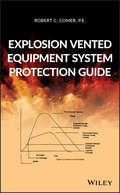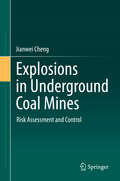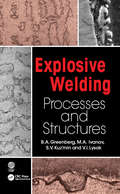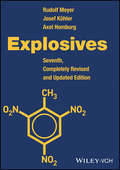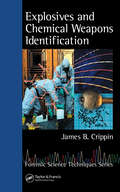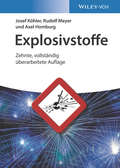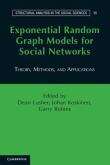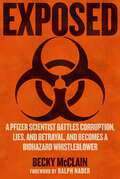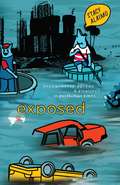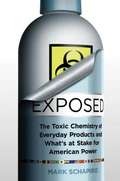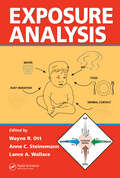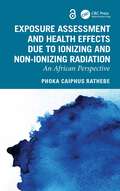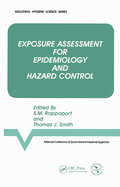- Table View
- List View
Explosion Vented Equipment System Protection Guide
by Robert C. ComerThis book provides complete step by step instruction, practical examples, guidance, and worksheets to meet the needs of a company licensed or competent unlicensed engineer that, by education or experience, understands the concepts presented in this book. This book will help engineers ensure that their company is in compliance with the new standard of dust collection systems by mitigating the exposed risks. The data is presented in tables and graphs along with examples that are based on actual, proven, practical designs to clearly illustrate application of the information provided. The book is broken down into two parts. Part 1 details structural analysis and design for reinforcing dust handling systems including Design criteria and general theory, Dust collector wall, roof and hopper sections, Access doors, hinges and latches, explosion vent ducts, blast deflectors, and filter bag cage design, Explosion vent duct weather covers, etc. Part 2 covers explosion relief elements and explosion flowing pressure analyses.
Explosions in Underground Coal Mines: Risk Assessment And Control
by Jianwei ChengThis book addresses the hazard of gas explosions in sealed underground coal mines, and how the risk of explosion can be assessed, modeled, and mitigated. With this text, coal mine operators and managers will be able to identify the risks that lead to underground mine gas explosions, and implement practical strategies to optimize mining safety for workers. In six chapters, the book offers a framework for understanding the sealed coal mine atmosphere, the safety characteristics that are currently in place, and the guidelines to be followed by engineers to improve upon these characteristics. The first part of the book describes the importance and characteristics of underground gas mine explosions in a historical context with data showing the high number of fatalities from explosion incidents, and how risk has been mitigated in the past. Chapters also detail mathematical models and explosibility diagrams for determining and understanding the risk factors involved in mine explosions. Readers will also learn about safety operations, and assessments for the sealed mine atmosphere. With descriptions of chapter case studies, mining engineers and researchers will learn how to apply safety measures in underground coal mines to improve mining atmospheres and save lives.
Explosive Welding: Processes and Structures
by B.A. Greenberg M. A. Ivanov S. V. Kuzmin V. I. LysakThis reference explores explosion welding, a high intensity, transient impact that achieves metal compounds not obtainable otherwise. Electron microscopy images cover the structure of numerous welded joints including titanium–orthorhombic titanium aluminide, copper–tantalum, aluminum–tantalum, iron–silver, steel–steel, and copper–titanium. These weldable pairs have different solubility than their initial elements. The authors present various processes and structures including granulating fragmentation, cusps, splashes, and quasi-wave interface. Specific risk zones for chemical and petrochemical (coke chamber) reactors are probed and suggestions offered. Key Features: Offers new theories about explosion welding processes and structures Investigates dozens of weldable pairs with differing solubility from initial elements Studies both hetero- and homogeneous pairs Explores welded joints with flat, wavy and quasi-wavy separation boundaries Observes irregularities of the separation surface relief observing asperities and splashes and their transformation under intensified welding modes Unveils a new type of fragmentation under explosion welding Explosive Welding: Processes and Structures is a valuable resource for a wide range of experts involved in explosion welding, engineers, as well as graduate and postgraduate students.
Explosives
by Axel Homburg Rudolf Meyer Josef KöhlerThe unrivaled, definitive reference for almost 40 years, this classic work on explosives is now in its seventh, completely revised and updated edition. Some 500 monographic entries, arranged alphabetically, consider the physicochemical properties, production methods, and safe applications of over 120 explosive chemicals. In addition, 70 fuels, additives, and oxidizing agents are discussed as well as the corresponding test methods. Trade, company, and military short names are provided for many of the materials listed, while further key features include a combined index and glossary with terms and abbreviations in English, French, and German, as well as conversion tables and many literature references. Finally, this indispensable source also contains safety data and transport regulations.
Explosives and Chemical Weapons Identification (Forensic Science Techniques)
by James B. CrippinChemicalsare a part of daily life and can be found all around us. Many common chemicals when mixed improperly � whether intentionally or not � can pose serious consequences to those who come in contact with them. Written by an author who is an experiencedhazmat-qualifiedfirst responder,forensicspecialist, and educator, Explosives and Chemical Weapo
Explosivstoffe
by Axel Homburg Rudolf Meyer Josef KöhlerAus Rezensionen voriger Auflagen: Die zehnte Auflage dieses Nachschlagewerkes ist erneut erweitert und aktualisiert worden, das bewährte Konzept wurde beibehalten. Der Textteil beschreibt ausführlich mehr als 550 Begriffe in alphabetischer Reihenfolge, darunter über 120 mit Strukturformel und Daten versehene chemische Verbindungen mit Explosivcharakter. Zu fast jeder Verbindung werden die wichtigsten chemisch-physikalischen und sicherheitstechnischen Kenndaten aufgeführt; die Gefahrgutregularien wurden gründlich überarbeitet. Der Leser findet außerdem Angaben zu den Herstellungsverfahren und Verwendungsmöglichkeiten dieser Stoffe sowie zu etwa 70 Additiven, Brennstoffen und Oxidantien. Etwa 1500 Einträge im Schlagwortregister, die Angabe der englischen und französischen Übersetzungen und die Erklärung von Kurzbezeichnungen machen dieses Buch zu einem umfassenden und aktuellen Lexikon. Es eignet sich für Fachleute, die in irgendeiner Form mit Explosivstoffen zu tun haben, aber auch für Interessenten, wie Übersetzer, Behörden und Patentanwälte. ' Ein Buch, das in mehr als 60 Jahren 8 Auflagen erlebt hat, bedarf keiner besonderen Empfehlung...' Archiv für Kriminologie
Exponential Random Graph Models for Social Networks
by Dean Lusher Johan Koskinen Garry RobinsExponential random graph models (ERGMs) are increasingly applied to observed network data and are central to understanding social structure and network processes. The chapters in this edited volume provide a self-contained, exhaustive account of the theoretical and methodological underpinnings of ERGMs, including models for univariate, multivariate, bipartite, longitudinal and social-influence type ERGMs. Each method is applied in individual case studies illustrating how social science theories may be examined empirically using ERGMs. The authors supply the reader with sufficient detail to specify ERGMs, fit them to data with any of the available software packages and interpret the results.
Exposed by Science! (Fountas & Pinnell Classroom, Guided Reading Grade 6)
by Timothy PaulsonNIMAC-sourced textbook
Exposed: A Pfizer Scientist Battles Corruption, Lies, and Betrayal, and Becomes a Biohazard Whistleblower
by Becky McClainA powerful memoir of a molecular biologist&’s courageous fight against corporate retaliation after revealing dangerous biosafety failures in biotech labs.When molecular biologist Becky McClain raised urgent alarms about biosafety lapses at her biotech lab at Pfizer, she expected concern--not retaliation. Instead, her warnings about dangerous, genetically engineered viruses that were handled without following standard safety protocols were met with hostility, intimidation, and ultimately, devastating illness after a workplace exposure changed her life forever.Exposed is McClain&’s riveting memoir of her transformation from dedicated scientist to the nation&’s first successful biotech whistleblower. Chronicling her battle against a powerful industry and its culture of secrecy, McClain reveals the high personal cost of speaking out, the legal showdown that rocked Pfizer, and the alarming gaps in biosafety and regulatory oversight that put workers--and the public--at risk.In a post-pandemic world, McClain&’s story is more urgent than ever: a wake-up call to the dangers lurking behind laboratory doors, a testament to the power of truth, and a courageous demand for accountability in science. Exposed is not just a personal journey--it&’s a public reckoning with the ethical failures and hidden hazards of 21st-century biotechnology.
Exposed: Desire and Disobedience in the Digital Age
by Bernard E. HarcourtExploiting our boundless desire to access everything all the time, digital technology is breaking down whatever boundaries still exist between the state, the market, and the private realm. Bernard Harcourt offers a powerful critique of what he calls the expository society, revealing just how unfree we are becoming and how little we seem to care.
Exposed: Environmental Politics and Pleasures in Posthuman Times
by Stacy AlaimoOpening with the statement &“The anthropocene is no time to set things straight,&” Stacy Alaimo puts forth potent arguments for a material feminist posthumanism in the chapters that follow.From trans-species art and queer animals to naked protesting and scientific accounts of fishy humans, Exposed argues for feminist posthumanism immersed in strange agencies and scale-shifting ethics. Including such divergent topics as landscape art, ocean ecologies, and plastic activism, Alaimo explores our environmental predicaments to better understand feminist occupations of transcorporeal subjectivity.She puts scientists, activists, artists, writers, and theorists in conversation, revealing that the state of the planet in the twenty-first century has radically transformed ethics, politics, and what it means to be human. Ultimately, Exposed calls for an environmental stance in which, rather than operating from an externalized perspective, we think, feel, and act as the very stuff of the world.
Exposed: The Toxic Chemistry of Everyday Products and What's at Stake for American Power
by Mark SchapiroThe United States was once the pioneer of new approaches to environmental protection. In the 1970s and 1980s an American mix of scientific rigor and legal muscle gave birth to a body of environmental regulations and laws that was seen as a model around the world. But no more; leadership has switched. The European Union is asserting new priorities that are far more protective of citizens' health and the environment than those in the United States and they have the economic muscle to back them up.
Exposure Analysis
by Wayne R. Ott Anne C. Steinemann Lance A. WallaceWritten by experts, Exposure Analysis is the first complete resource in the emerging scientific discipline of exposure analysis. A comprehensive source on the environmental pollutants that affect human health, the book discusses human exposure through pathways including air, food, water, dermal absorption, and, for children, non-food ingesti
Exposure Assessment and Health Effects Due to Ionizing and Non-Ionizing Radiation: An African Perspective
by Phoka Caiphus RathebeThis book describes and outlines exposure scenarios of ionizing and non‑ionizing radiation in occupational and residential settings within the African continent, where technological developments and mining activities are the main sources of radiation exposure. To better understand these exposure scenarios, this book focusses on all exposure aspects of both ionizing and non‑ionizing radiation from an African perspective.This book Covers occupational and residential exposure to ionizing radiation emanat‑ing from mining activities, particularly from an African perspective Explores exposure to radon and uranium from abundant mines and tailings Reviews non‑ionizing radiation exposure assessments for communication and power sources Discusses health effects of ionizing and non‑ionizing radiation among the general public Examines health effects of exposure to mining, electric utility, and communication device operations This book is aimed at graduate students and researchers in bioengineering and environmental health, and radiobiology.
Exposure Assessment for Epidemiology and Hazard Control
by American Conference of Governmental Industrial HygienistsWhat agents should be measured?How should measurement be performed and what averaging time should be used for the measurement?What sampling strategy should be employed to characterize exposures across individuals, locations, and time?What durations of exposure should be characterized?What statistical descriptors should be used to relate exposure to effect?Exposure Assessment for Epidemiology and Hazard Control examines various approaches to answering these and other important questions. Other topics discussed include the measurement of current exposures (e.g., vapors, gases, aerosols, and complex mixtures); the application of toxicological relationships, including biological markers and sample models; an epidemiological evaluation of exposure-effect relationships, including new methods for effect evaluation and models for population exposure estimates; and strategies for exposure assessment, such as biological sampling interpretation through toxicokinetic processes. This important new volume contains essential information for industrial hygienists, epidemiologists, occupational health physicians, toxicologists, and immunologists.
Exposure Of The American Population To Radioactive Fallout From Nuclear Weapons Tests
by Committee to Review the CDC-NCI Feasibility Study of the Health Consequences from Nuclear Weapons TestsThis report is a review of the draft feasibility study that was issued at the request of Congress by the Centers for Disease Control and Prevention (CDC) and the National Cancer Institute (NCI). Over 500 atmospheric nuclear-weapons tests were conducted at various sites around the world during 1945-1980. As public awareness and concern mounted over the possible health hazards associated with exposure to the fallout from weapons testing, a feasibility study was initiated by CDC and NCI to assess the extent of the hazard. The CDC-NCI study claims that the fallout might have led to approximately 11,000 excess deaths, most caused by thyroid cancer linked to exposure to iodine-131. The committee noted that CDC and NCI used the best available data to estimate exposure and health hazards. The committee does not recommend an expanded study of exposure to radionuclides other than 131I since radiation doses from those radionuclides were much lower than those from 131I. It also recommended that CDC urge Congress to prohibit the destruction of all remaining records relevant to fallout.
Exposure of the American People to Iodine-131 from Nevada Nuclear-bomb Tests: Review of the National Cancer Institute Report and Public Health Implications
by Institute of Medicine National Research CouncilIn 1997, after more than a decade of research, the National Cancer Institute (NCI) released a report which provided their assessment of radiation exposures that Americans may have received from radioactive iodine released from the atomic bomb tests conducted in Nevada during the 1950s and early 1960s. This book provides an evaluation of the soundness of the methodology used by the NCI study to estimate: Past radiation doses. Possible health consequences of exposure to iodine-131.Implications for clinical practice. Possible public health strategies--such as systematic screening for thyroid cancer--to respond to the exposures. In addition, the book provides an evaluation of the NCI estimates of the number of thyroid cancers that might result from the nuclear testing program and provides guidance on approaches the U.S. government might use to communicate with the public about Iodine-131 exposures and health risks.
Exposure to Contaminants in Drinking Water: Estimating Uptake through the Skin and by Inhalation
by Stephen S. OlinExposure to Contaminants in Drinking Water: Estimating Uptake through the Skin and by Inhalation examines the current state of science in this field by identifying and reviewing the available information resources; evaluating various models and approaches; and demonstrating the feasibility of developing estimates of the distribution of absorbed doses of contaminants in drinking water through contact with the skin and by inhalation. This book, the product of a fifteen-member expert working group convened by the Risk Science Institute of the International Life Sciences Institute under a cooperative agreement with the U.S. Environmental Protection Agency's Office of Water, includes contributions from experts in exposure modeling and measurement; water chemistry; time-activity patterns; dermal and respiratory uptake; and the use of probability distributions in characterizing exposures.
Expression Profiling in Neuroscience
by Yannis KaramanosTranscriptomics and proteomics, studying the profile of the expression of nucleic acids and proteins respectively, are increasingly applied to gain a mechanistic insight into a wide spectrum of investigation, and the use of expression profiling studies for the central nervous system and brain function aids in the understanding of neurodegenerative disorders and tumor development mechanisms. In Expression Profiling in Neuroscience, expert researchers provide a survey of the most commonly used approaches in the field and scan the different ways of studying the central nervous system/brain environment through expression profiling. The first part addresses the gene expression profiling of the brain at a large scale or to a specific cell type such as blood-brain barrier endothelium. Then, the second part describes the protein expression studies and the different technologies applied. Written for the popular Neuromethods series, chapters include corresponding background information, tested laboratory protocols, and step-by-step methods for reproducible laboratory experiments. Detailed and authoritative, Expression Profiling in Neuroscience presents the state-of-the-art techniques necessary to expand research further into this vital area of study.
Expression, Purification, and Structural Biology of Membrane Proteins (Methods in Molecular Biology #2127)
by Camilo Perez Timm MaierThis book collects up-to-date advanced protocols and advice from leading experts in the area of membrane protein biology that can be applied to structural and functional studies of any membrane protein system. The contents explore methods for cloning and expression of membrane proteins and membrane protein complexes in prokaryotic and eukaryotic systems, approaches for protein purification, nanobody applications, as well as biophysical characterization and much more. Written for the highly successful Methods in Molecular Biology series, chapters include introductions to their respective topics, lists of the necessary materials and reagents, step-by-step, readily reproducible laboratory protocols, and tips on troubleshooting and avoiding known pitfalls. Authoritative and thorough, Expression, Purification, and Structure Biology of Membrane Proteins serves to guide and encourage young researchers and newcomers to the field to tackle bold new studies on membrane proteins.Chapter 11 is available open access under a CC-BY 4.0 license via link.springer.com.
Expressly Human: Decoding the Language of Emotion
by Mark Changizi Tim BarberGood communication, conventional wisdom suggests, is calm, logical, rational. Emotions, we&’re told, just get in the way. But what if this is backwards? What if those emotional overtones are the main messages we&’re sending to one another, and all that logical language is just window dressing? Over billions of years of evolution, animals have become increasingly sophisticated and increasingly sentient. In the process, they evolved emotions, which helped improve their odds of survival in complex situations. These emotions were, at first, purely internal. But at some point, social animals began expressing their emotions, in increasingly dramatic ways. These emotional expressions could accurately reflect internal emotions (smiling to express happiness)—or they could be quite different (smiling to cover up that you&’re actually furious, but can&’t tell your boss that). Why did once-stone-faced animals evolve to be so emotionally expressive—to be us? The answer, as evolutionary neurobiologist Mark Changizi and mathematician Tim Barber reveal, is that emotional expressions are our first and most important language—one that allows us, as social animals, to engage in highly sophisticated communications and negotiations. Expressly Human introduces an original theory that explains, from first principles, how the broad range of emotional expressions evolved, and provides a Rosetta Stone for human communication. It will revolutionize the way you see every social interaction, from deciding who gets the last slice of pizza to multimillion-dollar business negotiations, and change your definition of what makes us human.
Exscalate4CoV: High-Performance Computing for COVID Drug Discovery (SpringerBriefs in Applied Sciences and Technology)
by Gabriella Bernardi Silvano ColettiThis book highlights the different aspects of the research project “E4C Horizon 2020 European Project” aimed at fighting the coronavirus by combining the best supercomputing resources and artificial intelligence with state-of-the-art experimental facilities up through clinical validation. Coronavirus disease has become an important public issue across the globe since December 2019. There is an urgent need to develop potent anti-COVID-19 agents for the prevention of the outbreak and stop viral infections. To this aim, a public–private consortium composed by European and national infrastructures, center of excellence, universities, and a pharmaceutical company started the E4C Horizon 2020 European Project: Its core idea was to use the EXaSCale smArt pLatform Against paThogEns (EXSCALATE) supercomputing platform for a process known as “drug repurposing”, namely to identify the most promising safe in man drugs for immediate treatment of the already infected population and then novel pan-coronavirus inhibitors to address future emergencies. This ambitious goal exploited a “chemical library” of 500 billion molecules, thanks to a processing capacity of more than 3 million molecules per second, made available by the computing power of the EXSCALATE platform.
Extended Abstracts Spring 2014
by Montserrat Corbera Josep Maria Cors Jaume Llibre Andrei KorobeinikovThe two parts of the present volume contain extended conference abstracts corresponding to selected talks given by participants at the "Conference on Hamiltonian Systems and Celestial Mechanics 2014" (HAMSYS2014) (15 abstracts) and at the "Workshop on Virus Dynamics and Evolution" (12 abstracts), both held at the Centre de Recerca Matemàtica (CRM) in Barcelona from June 2nd to 6th, 2014, and from June 23th to 27th, 2014, respectively. Most of them are brief articles, containing preliminary presentations of new results not yet published in regular research journals. The articles are the result of a direct collaboration between active researchers in the area after working in a dynamic and productive atmosphere. The first part is about Central Configurations, Periodic Orbits and Hamiltonian Systems with applications to Celestial Mechanics - a very modern and active field of research. The second part is dedicated to mathematical methods applied to viral dynamics and evolution. Mathematical modelling of biological evolution currently attracts the interest of both mathematicians and biologists. This material offers a variety of new exciting problems to mathematicians and reasonably inexpensive mathematical methods to evolutionary biologists. It will be of scientific interest to both communities. The book is intended for established researchers, as well as for PhD and postdoctoral students who want to learn more about the latest advances in these highly active areas of research.
Extended Biocontrol
by Xavier Fauvergue Adrien Rusch Matthieu Barret Marc Bardin Emmanuelle Jacquin-Joly Thibaut Malausa Christian LannouThis book presents an exhaustive overview of the theoretical foundations and practical applications of biocontrol in agriculture. It encompasses all kinds of nature-based approaches for crop protection: introduction and conservation of natural enemies, release of sterile insects, enhancement of plant defenses, use of microorganisms, biopesticides, and semiochemicals. Cutting-edge knowledge in population biology, microbial ecology, epidemiology and chemical ecology is presented in accessible terms. The potential of field application is discussed with regard to practical aspects but also socioeconomic constraints. The 62 authors are researchers from a large panel of disciplines, from theoretical biology to social sciences.
Extended Finite Element Method
by Amir R. KhoeiIntroduces the theory and applications of the extended finite element method (XFEM) in the linear and nonlinear problems of continua, structures and geomechanicsExtended Finite Element Method: Theory and Applications introduces the theory and applications of the extended finite element method (XFEM) in the linear and nonlinear problems of continua, structures and geomechanics. The XFEM approach is based on an extension of standard finite element method based on the partition of unity method.Extended Finite Element Method: Theory and Applications begins by introducing the concept of partition of unity, various enrichment functions, and fundamentals of XFEM formulation. It then covers the theory and application of XFEM in large deformations, plasticity and contact problems. The implementation of XFEM in fracture mechanics, including the linear, cohesive, and ductile crack propagation is also covered. The theory and applications of the XFEM in multiphase fluid flow, including the hydraulic fracturing in soil saturated media and crack propagation in thermo-hydro-mechanical porous media, is also discussed in detail.Introduces the theory and applications of the extended finite element method (XFEM) in the linear and nonlinear problems of continua, structures and geomechanicsExplores the concept of partition of unity, various enrichment functions, and fundamentals of XFEM formulation.Covers numerous applications of XFEM including fracture mechanics, large deformation, plasticity, multiphase flow, hydraulic fracturing and contact problemsAccompanied by a website hosting source code and examples
